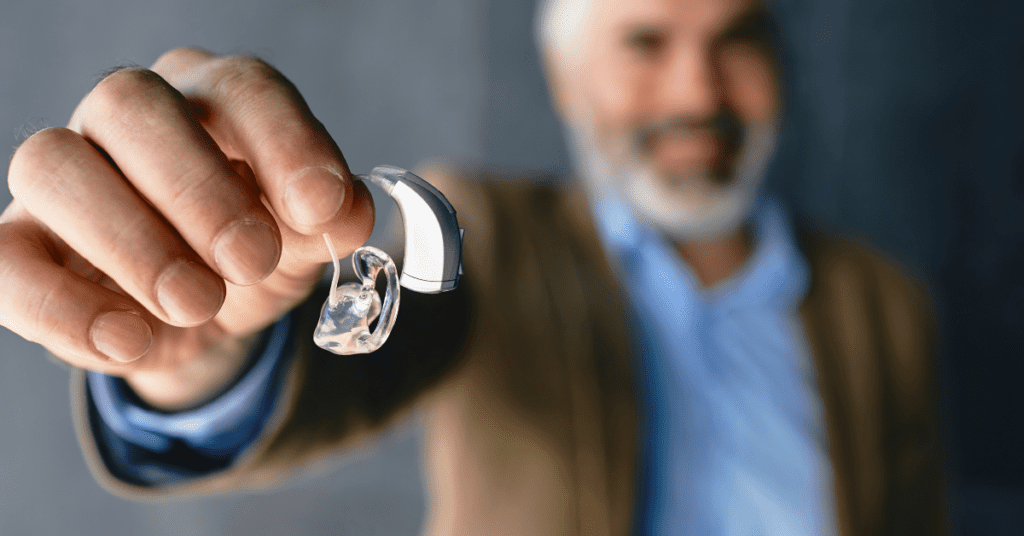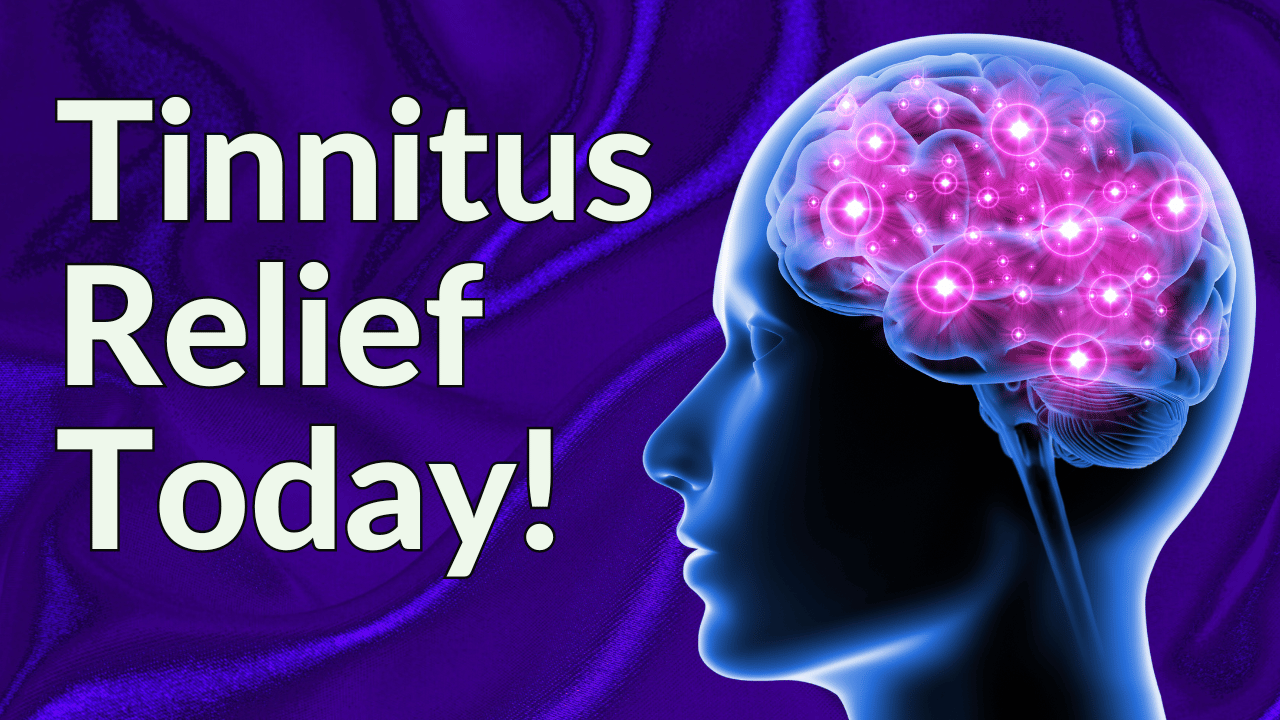You may know by now that hearing aids are one of the most recommended treatment options for tinnitus management. Sometimes used alone, but most of the time as part of a more comprehensive treatment plan, hearing aids for tinnitus relief have been shown to effectively address the auditory components of tinnitus and, in some cases, provide additional tinnitus relief through built in or app based sound therapy. Let’s explore some of the most advanced options for hearing aids available for severe tinnitus on the market today.
"Treble Health helped me reduce my tinnitus by about 80%, and now I can live my life again!"


"Treble Health helped me reduce my tinnitus by about 80%, and now I can live my life again!"
– Steve D.
Book a free consultation to learn which Treble Health solution is right for you. Join Steve and thousands more who have found lasting tinnitus relief.
Tinnitus: An Overview
Before understanding which hearing aids are best for tinnitus, or determining how wearing hearing aids can help tinnitus patients, it is important to understand exactly what tinnitus is, how it can affect people, and how a prescription hearing aid is able to effectively target the symptoms of tinnitus to provide relief over the long-term. Far from simply reducing background noise, or even relegating phantom sounds to essentially become background noise, hearing aids can support other treatment modalities, and address some of the fundamental issues that lead to tinnitus.



What Is Tinnitus?
Tinnitus is best described as the perception of sound, without an external sound present in the environment. There are different types of tinnitus, but all have this in common: sound is heard, without a recognized, or identifiable external source. These sounds are typically referred to as phantom sounds, and may or may not be accompanied by other hearing issues, such as hearing loss. Tinnitus is a fairly common condition, estimated to affect as many as 1 in 5 people today. While 80% of tinnitus patients report non-functional impact to their daily lives, 20% report severe tinnitus causing significant disruption to their functional ability to perform daily tasks, including working, sleeping, reading, and more.
Although the most commonly reported tinnitus sound reported is ringing, tinnitus can also sound like buzzing, hissing, and whooshing, and can affect one or both ears – however, the exact sounds experienced among tinnitus patients is varied. Symptoms of tinnitus do not typically occur in a single, unending stream, but flare and ebb over a period of hours, days, weeks, or even months, making it important for many to find a way to successfully and consistently relieve tinnitus symptoms.
What Are The Most Common Causes Of Tinnitus?
90% of people with tinnitus also experience hearing loss, from severe hearing loss to a more mild form of hearing loss. For these individuals, wearing hearing aids may already be a regular practice, but different hearing aid settings and additional therapies can elevate standard or OTC hearing aids to a more useful and successful intervention. Hearing loss of any type is ultimately considered the most common cause of tinnitus. That being said, there are many other potential causes, which may include:
- Head Injuries
- Neck Injuries
- Medications
- Ototoxic Exposures
- Hypertension
- Diabetes
- Kidney Disease
- Meniere’s Disease
- Autoimmune disorders
Tinnitus can also be caused by a combination of hearing loss and any of the other conditions listed above. While hearing loss may often encourage people to turn to a hearing device, the other conditions might not be quite as clear-cut, which can make finding tinnitus treatment without a dedicated team a difficult journey. Fortunately, a hearing health professional like an audiologist can help address both tinnitus treatment and mild to moderately severe and even severe hearing loss.
Can A Hearing Aid Reduce Tinnitus Symptoms?


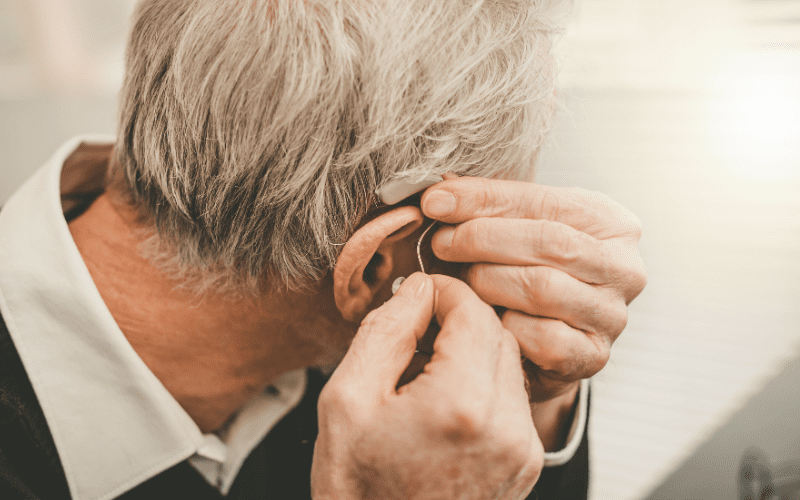
Yes, absolutely! Most tinnitus treatment plans include amplification recommendations like a hearing aid. Hearing aids can be utilized to address tinnitus management and provide tinnitus relief in a couple of important ways, including the following:
- They fill the void of missing sound created by the hearing loss, which helps to reduce the overactive neuron firing in the auditory cortex, which is thought to lead to the onset of tinnitus symptoms.
- Hearing aids help to provide background noise to help reduce the awareness of tinnitus symptoms (called masking/attentional effects), providing auditory stimulation and improved communication.
- Some hearing aids provide a built in tinnitus therapy signal, which can be used simultaneously with the amplification properties of the hearing aid to provide all-day tinnitus relief.
While you may not initially think “tinnitus management” when you think of hearing aids, they can be extremely valuable to provide tinnitus relief, and address tinnitus treatment in a more holistic and effective way than many of the supposed “therapies” that have been targeted toward those desperate for relief from their symptoms.
Do Hearing Aids Help High Frequency Tinnitus?
Hearing aids can help high frequency tinnitus and provide tinnitus relief while addressing severe to moderate hearing loss. Two of the most common types of hearing loss associated with tinnitus include age related hearing loss and noise induced hearing loss. Both of these hearing losses typically result in high-frequency, sensorineural hearing loss, which can result in high-pitched (also called high frequency) tinnitus symptoms.
Because we have already established that hearing aids are beneficial in many different ways, including reducing tinnitus symptoms and their severity, it goes without saying that they could be especially helpful for those with high frequency tinnitus due to their ability to amplify these ranges of hearing and provide environmental exposure to new sounds. Both allow the brain to reduce awareness of tinnitus, even without maskers, such as nature sounds or white noise.
What To Know Before Purchasing A Hearing Aid
Hearing aids are not all created equally; different brands and manufacturers will offer solutions that may not be appropriate for everyone experiencing tinnitus symptoms. Speaking with a licensed hearing professional to go over options that will be appropriate for both hearing loss and tinnitus symptoms will help you achieve tinnitus relief more effectively. Tinnitus features are not standard in all hearing aids. Therefore, it’s crucial not to buy hearing aids impulsively. Instead, consult with a hearing specialist to determine the technology that best addresses your unique needs, especially for managing tinnitus symptoms based on your individual physiology and background.
Prescription Hearing Aids
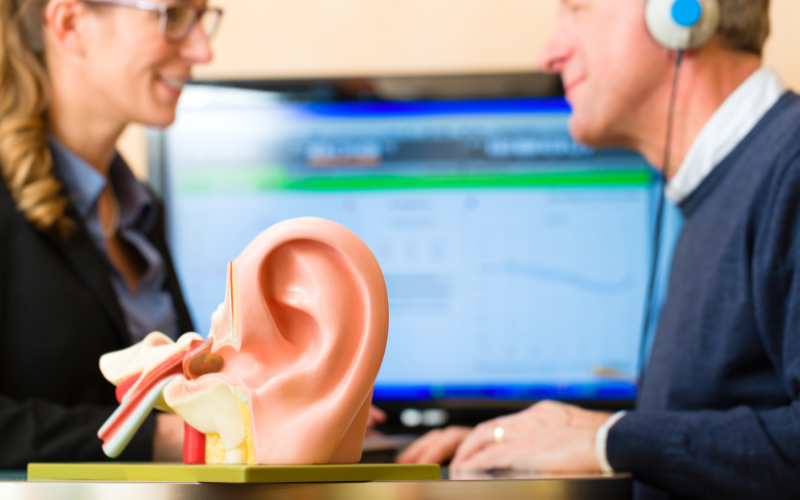


Prescription hearing aids are dispensed and fit by an audiologist or a Board Certified Hearing Instrument Specialist. Providers will first perform diagnostic testing, and customize all hearing aid settings according to the results of these diagnostic tests. These devices are typically combination-style devices, wherein both prescriptive hearing aid amplification and customizable ear-level sound therapy intervention are delivered through one device. These are typically the more costly option for modern hearing aids, and may range from $2,000 to $8,000 for a pair of devices, usually including professional services in addition to the initial hearing test. The delivery and fitting of these devices and follow up care is provided in in-person settings.
OTC Hearing Aids
These are relative newcomers to the hearing aid industry, and are available online from many hearing aid companies (i.e. Jabra Enhance hearing aids or Eargo hearing aids). These are called self-fitting hearing aids, or aids that the consumer is able to program and customize through the use of online hearing screening tools and apps. Although they do often have access to professional services support from licensed audiologists or hearing instrument specialists as well, these services are usually offered via remote care or telehealth services.
Self-fitting OTC hearing aids are not programmable to a given patient’s diagnostic hearing test. They do not include any type of tinnitus sound generator to provide ear-level sound therapy. This means that these hearing aids only address general hearing health, and do not necessarily help address the issues unique to tinnitus. The cost range may initially be more attractive (cost ranges from $700 to $2,900 per pair), but the lack of tinnitus management can prove frustrating for those who are specifically using hearing aids for tinnitus management or symptom relief.
Self-Fitting Hearing Aids
As its name suggests, a self-fitting hearing aid is one that does not require purchasing hearing aids with the help of a hearing health professional, and hearing aids for tinnitus fall into one of two categories: prescription hearing aids and OTC hearing aids. Typically, a prescription hearing aid is going to be prescribed by a hearing health professional, and your hearing aid purchase will be supported alongside a professional, who may be certified by the American Tinnitus Association and/or other governing board in your state or county. A self-fitting aid is one that does not require a hearing health professional to purchase, and does not include or require a hearing professional to program or in any way work with the device. The hearing aid style itself does not necessarily play into treating tinnitus or dictating one of these two categories, as both professional hearing aids and an OTC hearing aid will offer different styles and types. We’ll go into greater detail below on the two categories of hearing aids.
What To Consider Before Buying A Hearing Aid



Before you purchase hearing aids for tinnitus, there are several important considerations to take into account. Differences in models and offerings can determine whether or not tinnitus management is effective for an individual’s specific tinnitus needs, including whether or not profound hearing loss is present, whether you prefer invisible hearing aids (also called completely-in-the canal hearing aids), and what type of sound quality you are looking for.
What’s The Difference Between Digital And Analog Hearing Aids?
One important difference to consider is the difference between digital and analog hearing aids. Most hearing aids on the market today are digital, as this type of technology allows for the greatest flexibility to provide noise reduction, signal processing, and customizable amplification levels dependent on the user’s specific hearing loss needs. Despite the prevalence of digital hearing aids, there are still hearing aid users who prefer hearing aid styles that utilize analog, and analog hearing aids can be found.
According to the FDA, the differences between the two are as follows:
- Analog hearing aids make continuous sound waves louder by amplifying all sounds (speech and noise) in the same way. For this reason, they may not be as customizable and able to effectively mask tinnitus sounds.
- Digital hearing aids have all of the features of analog programmable hearing aids, but they convert sound waves into digital signals and produce an exact duplication of a given sound. Microchips within digital hearing aids are able to analyze speech and other environmental sounds and store multiple program settings for a more customizable experience–though the precise offerings for various hearing aids will depend on brand, price range, and availability.
Which Is Better: In-The-Ear Or Behind-The-Ear Hearing Aids?
Finding the best hearing aid is not quite black and white; after all, different hearing aids appeal to different people. Some prioritize finding invisible hearing aids for tinnitus, while others prefer finding a more powerful unit or one with more features such as rechargeable batteries or Bluetooth connectivity. When looking at in the canal hearing aids versus behind the ear, it is important to understand that one isn’t necessarily superior to the other. Each has its own features and sources of appeal, as well as its own approach to sound quality. Determining which is better requires you to take stock of what you need, and ultimately decide which is the best hearing aid for you.
Completely-In-The-Canal (CIC) Hearing Aid
CIC hearing aids fit completely within the ear canal; absolutely nothing resides outside of the ear canal. This particular style is most appropriate for those with mild to moderate hearing loss, so they do not experience occlusion of sound from the hearing aid filling the external auditory canal. These devices are small and out of the way, but they may not offer more advanced and useful features, such as Bluetooth compatibility, app controls, and sound therapy.
Receiver-In-Canal (RIC) Hearing Aid
This is the most common style of hearing aid used among adults seeking tinnitus relief. This style has two parts: a small, behind the ear component and an in the ear speaker connected via a wire. This style allows for the ear canal to remain un-occluded; therefore, the user can still access their natural hearing ability for low and mid-frequency sounds, amplifying only the parts of their hearing that need assistance. This is also useful for tinnitus interventions.
Additional Hearing Aid Features To Consider
Hearing aid users differ vastly in what they want from their hearing aids. The standard concerns–think tinnitus intervention and effective amplification–can also be accompanied by features like fall detection. The most common hearing aid features to look into include:
- Bluetooth hearing aids. Modern hearing aids frequently offer Bluetooth compatibility, as Bluetooth hearing aids can link to phones and other devices to deliver masking programs, and even answer phone calls. Bluetooth compatibility can be immensely helpful for tinnitus relief, because it can allow users to access more sound therapy options. By streaming sound therapy apps directly to their hearing aids from their mobile phones, users can easily and conveniently access tinnitus treatment. Tinnitus apps with this include Resound Tinnitus Relief app, Oticon Tinnitus Relief app, Starkey Relax app, Widex Zen app, Calm app, and Relax Melodies app.
- Tinnitus sound generator. A tinnitus sound generator is useful, as most prescription hearing aids for tinnitus relief have built in sound generators that are customizable and programmable by the patient’s hearing health professional (or audiologist). These built-in sound generators allow the user to simply wear their devices with their prescribed settings, without having to use other tinnitus relief app options and additional features to experience relief from tinnitus.
- Rechargeable hearing aids. Rechargeable hearing aids are certainly convenient, but not everyone prefers this style as it often results in a larger hearing aid style. Many tinnitus patients prefer to wear their devices to bed at night to administer sound therapy, and rechargeable hearing aids are better suited for this task, as the batteries will typically go 12-16 hours before needing to charge.
What Type of Hearing Aid Is Best For Tinnitus?
The best hearing aids for tinnitus are varied. From the best rechargeable hearing aids to the best in the ear canal hearing aids that allow users to answer phone calls, there are a host of different options currently available. Many reputable brands are available, but some of the most commonly used hearing aids for tinnitus are:
- Widex hearing aids. Widex has been a pioneer in tinnitus therapy using its Zen technology since 2012, Zen technology utilizes fractal tones as part of their tinnitus treatment package. Recently, they have also added relaxing sounds such as wave patterns and wind, which can be blended with the original fractal tones. Current hearing aid: Widex Moment
- Oticon hearing aids. Oticon hearing aids are best known for their AI technology (or “brain learning” technology), for hearing aid amplification. They utilize Shaped Sound for their tinnitus sound generator, but other sounds such as pink noise, white noise, and red noise are also available. The sound generator can be presented steadily or as a modulated sound signal to mimic an ocean pattern. Current hearing aid: Oticon Real.
- Phonak hearing aids. Phonak hearing aids offer their Phonak tinnitus balance program, though there are only broadband noises provided through the hearing aids. Broadband noises are audiogram based, and include white noise and pink noise. Current hearing aid line: Phonak Lumity. There is also the Phonak Lyric, which is a semi-implantable, extended wear device that has the potential to offer tinnitus relief as a result of 24/7 amplification. This feature is in contrast to most hearing aids, which are designed for use during waking hours only.
- Starkey hearing aids. Starkey hearing aids are known for their AI offerings, like fall detection, and their multiflex tinnitus feature, which provides white noise therapy, audiogram shaped noise therapy, or customizable therapy to be determined by your hearing health professional following a hearing test. Current hearing aid line: Starkey Genesis AI.
- Resound hearing aids. There are two categories of masking sounds for tinnitus in Resound devices. These include broad band sounds (think high frequency noise, white noise, speech noise, and pink noise) and nature sounds, which can include ocean patterns. Current hearing aid line: Resound Omnia.
- Signia hearing aids. Signia hearing aids provide notch therapy, static noise therapy, and ocean wave therapy. Static noise therapy includes white noise, pink noise, speech noise, high-tone noise, and brown noise. Ocean wave therapy comes equipped with different patterns according to user preference.
Tinnitus Treatment And Therapy Options
Tinnitus treatment encompasses numerous different interventions and modalities, but hearing aids are among the first treatments used to address tinnitus. Whether hearing aids are used as the primary intervention, or hearing aids are only a peripheral intervention, there are several different ways to address hearing loss–with or without the best hearing aids currently on the market.
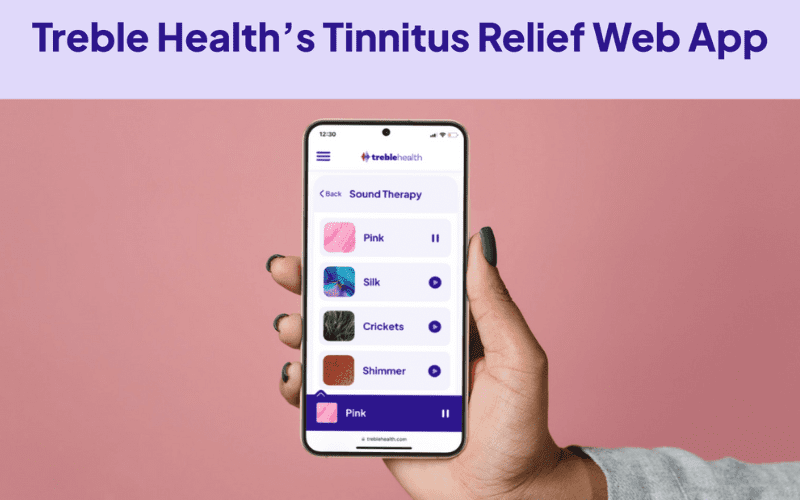


- Tinnitus Retraining Therapy (TRT). TRT is a treatment approach utilizing both hearing aids and tinnitus masking, rounded out with educational counseling to help tinnitus patients find relief from their tinnitus symptoms. TRT recognizes the importance of treating underlying hearing loss by providing the brain with environmental sounds and improved communication, as well as providing prescriptive sound therapy treatment (often in a combination device, like some of the hearing aids identified above, though traditional hearing aids can also be used).
- Cognitive Behavioral Therapy (CBT). CBT is a therapy method frequently used by mental health professionals. It focuses on addressing an individual’s response to their circumstances and helping developing healthy coping mechanisms and frameworks in which to address their emotions, behaviors, and thoughts to arrive at better outcomes. CBT can be used to ease the depression and anxiety that often accompany ear disorders and their most common complications, including tinnitus and hearing loss. It does not typically involve hearing aids.
- Sound Therapy. Sound therapy intervenes by providing a contrasting, soothing sound to a tinnitus or hearing loss patient’s environment during both awake and sleeping hours. This can effectively distract the brain and provide relaxation to the overworked limbic system of a tinnitus sufferer.
- Hearing Aids. Finally, no matter the precise hearing aid brand, using hearing aids for tinnitus is beneficial, as it allows the user to hear more sounds to help mask or cover up tinnitus. These aids can also provide targeted sound therapy using white noise and other pre-programmed sounds via built-in sound therapy technology or Bluetooth streaming technology.
Hearing aids can be used to address mild, severe, and moderate hearing loss, and background noises such as nature sounds can help mask the sounds of tinnitus. By combining the two, tinnitus patients can enjoy the benefits of amplified sound, and the intervention of sound therapy. Again, the best hearing aid might be different for each person depending on their hearing loss and tinnitus needs. It is important to partner with your hearing health professional to determine which of today’s numerous offerings might be the best fit for you!
The Treble Health Team Is Here To Help You
Our Treble Health audiologists have decades of experience treating various types of tinnitus, and can help you along the way – regardless of where you currently are in your journey. If you have any tinnitus related questions, we encourage you to schedule a complimentary telehealth consultation with our team. This call comes with no obligation, and is an opportunity for you to have any questions answered, and learn about the different treatment options that would work for your specific situation. Take the first step to finding tinnitus relief, and schedule your complimentary telehealth consultation today.
Next Step: Book Free Consultation
- 75% of patients reduced their tinnitus within three months after following our recommendations.
- "I feel like Treble Health literally gave me my life back." - Randy S. (verified customer)
- Join thousands of people who have reduced their tinnitus after scheduling a free consultation.






